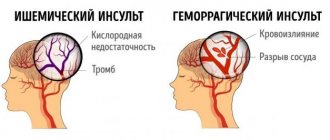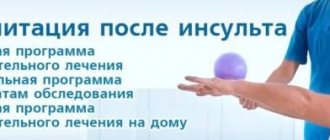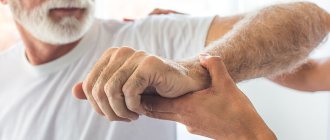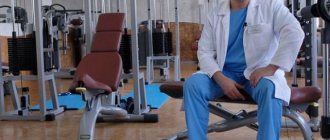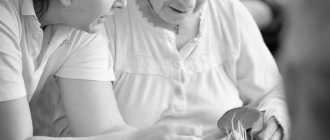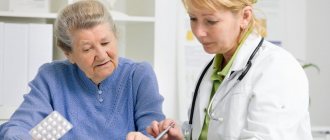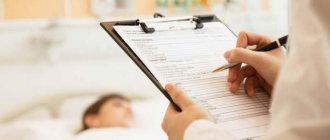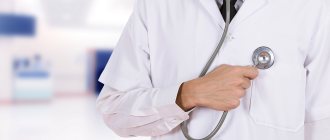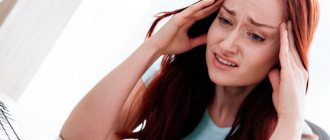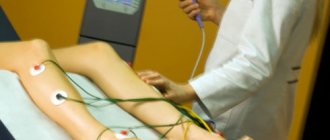Rehabilitation after a stroke makes it possible to partially regain lost skills, because regardless of health status, a person does not want to be a burden to his family. According to statistics, rehabilitation after a stroke gives a positive result of 70% and can be carried out not only in rehabilitation centers after a stroke, but also in boarding houses for the elderly.
Doctors noted that in patients who have suffered an ischemic stroke, the rehabilitation program gives good results, which is different from lesions after a hemorrhagic stroke.
Types and signs of stroke
A stroke is characterized by a sudden disruption of blood circulation in parts of the brain. There are two types of this pathological condition:
- ischemic – develops with narrowing and blockage of blood vessels;
- hemorrhagic - caused by serious damage or complete rupture of the arteries.
The subsequent rehabilitation program directly depends on the nature of the brain damage. It also affects the duration and prospects of recovery.
With any type of stroke, the cells of the nerve centers of the brain that are responsible for speech, vision, cognitive abilities, movements, etc. are affected. The degree of trauma is determined by the duration of the cerebrovascular accident and the general state of health.
Severe signs of a stroke, in which you need to urgently call an ambulance:
- severe weakness;
- numbness of the muscles of the face or limbs (sometimes on one side of the body);
- sudden deterioration of vision;
- unreasonable loss of coordination;
- difficulty speaking;
- problems with swallowing;
- convulsions;
- loss of consciousness;
- dizziness;
- throbbing headaches.
Therapy for acute cerebrovascular accident will be successful if you pay attention to the signs of this condition in time. The faster a person receives medical assistance, the greater the chances of a speedy recovery, since the higher the probability of keeping as many neurons alive as possible.
Emergency treatment is most effective within three to six hours of the first signs. After this time, changes in the affected areas of the brain may become irreversible, even if the patient was able to suffer a stroke.
Blood pressure measurement
The indicator gives an idea of the functioning of the cardiovascular system. Sudden changes should alert you; if everything is within normal limits, then you don’t have to worry about hidden complications from this side. To determine the tactics, it is advisable to undergo an examination and consult a cardiologist if problems in this area were observed during or before the illness.
Saturation - what should be the values?
Blood oxygen saturation shows how much of this vital gas for organs is currently contained and circulating in the blood. A normal level is considered to be between 94-96%, maybe higher. When it falls below the permissible value, hypoxia begins, indicating poor condition of the lungs and probable hidden inflammatory processes in the respiratory organs.
Stages of rehabilitation
Order of the Ministry of Health of the Russian Federation No. 1705n dated December 29, 2012 “On the procedure for organizing medical rehabilitation” approved the stages of rehabilitation measures depending on the severity of the condition [2]:
- Primary rehabilitation is carried out in the intensive care unit or intensive care unit, when the pathology is still in the acute phase, but the patient’s condition has already been stabilized. This recovery period lasts up to three to four weeks. At this time, a person can constantly be in a supine position; rehabilitation measures are carried out taking into account his condition. These include the prevention of bedsores, breathing exercises, classes to return normal speech functions, massage, and electrical stimulation.
- The second stage occurs after the end of the acute period. Then the person can already move to some extent, but the ability to self-service has not fully returned. The patient undergoes a rehabilitation program in an inpatient medical rehabilitation unit or rehabilitation center. The first three months are especially important. After a stroke, a victim is engaged in passive kinesiotherapy and physiotherapy. Rehabilitation specialists also pay attention to eliminating speech disorders and returning normal cognitive functions.
- The third stage occurs when a person, after a stroke, has become stronger and independent in self-care, communication, and movement. Rehabilitation is carried out on an outpatient basis, rehabilitation centers, and at home. The techniques are aimed at restoring motor, mental, and mental functions. Occupational therapy with exercises for the development of fine motor skills, classes with a speech therapist and psychologist are added to the main rehabilitation course.
The choice of restorative techniques depends on the individual characteristics of the patient, current condition, and concomitant diseases. Each stroke victim is given their own methods of rehabilitation, which have proven effective in similar cases.
Initial period
The duration of the initial period is 6 months. During this period, basic drug therapy is supplemented with nootropic drugs, vitamin complexes and sedatives. From the moment consciousness is restored, in addition to rubbing with camphor alcohol and frequent turning over, massage of the chest and passive movements of the limbs are carried out. On the third day, breathing exercises are started.
By the end of the first week, the patient is recommended to sit and make active movements of the limbs. The selected exercises must be performed several times a day, the duration of the exercises depends on the patient’s capabilities. You shouldn't do them forcefully. After a few more days, the doctor may allow you to move around.
After 2 weeks, doctors allow you to attend physical therapy classes in the gym. The selected set of exercises is performed slowly and smoothly, while the patient is assisted in this by a trainer. He shows the correct technique for doing the exercises so that you can do them yourself in the future.
Terms of rehabilitation
There is no specific time frame for recovery after a cerebrovascular accident. The duration of the rehabilitation program depends on various factors:
- what size and location is the affected area;
- how quickly the patient received medical care;
- what type of stroke;
- what is the patient’s health status;
- what rehabilitation course is prescribed.
But in any case, a person and his loved ones should prepare for the fact that it will take at least three months to recover. Already in the first stages, it is possible to identify some prognostic factors that determine the timing and possibility of recovery:
- favorable – spontaneous return of lost functions, high-quality and early rehabilitation program, preservation of the patient’s intelligence and activity;
- unfavorable - a large lesion or its location in functionally significant areas of the brain, old age, cognitive or emotional disorders, severe severity of defects, poor health.
The following table will help you navigate the rehabilitation time frame.
| Type of stroke | Consequences | Possible outcome of a rehabilitation program |
| Pathology with minimal neurological deficit | Mild paralysis of the face or limbs, problems with vision and coordination | Partial return of lost functions in one to two months, full recovery in three months (the exact timing is determined by the state of health) |
| Severe neurological deficit | Extensive paralysis of the face or limbs, significant loss of coordination | The ability to self-care returns on average within six months; it can take years to restore lost functions |
| Severe hemorrhagic or ischemic stroke with persistent neurological deficit | Paralysis and other consequences of circulatory disorders lead to disability | Patients can partially recover in one to two years. A complete return to previous life is impossible due to the death of important neurons, whose functions cannot be performed by other cells. |
Rehabilitation methods
Patients after a stroke usually need rehabilitation measures to recover from three main types of disorders:
- damage, defects - paresis, aphasia, ataxia;
- social maladjustment – problems with everyday skills, communication, ability to work;
- complete or partial loss of skills - impaired walking, self-care, etc.
In modern rehabilitation practice, there are several main areas of work with patients who have suffered a stroke. Rehabilitators help restore:
- motor skills and motor abilities;
- clarity of vision;
- everyday skills;
- normal speech;
- cognitive functions.
The ability to restore lost functions is explained by the plasticity of the nervous system, which is based on the ability of different parts of the central nervous system to be multifunctional. Over time, neurons take over the functions of damaged areas. This is facilitated by relieving cerebral edema and normalizing blood supply in areas bordering the affected area.
The most important rehabilitation measures after a stroke include drug therapy, kinesiotherapy, psychotherapy, physiotherapy, and classes with a speech therapist.
Rules for caring for victims after a stroke
The rehabilitation program should begin as soon as the person’s condition becomes stable, the sooner the more effective. In this matter, an individual approach is very important. Rehabilitation specialists carefully study the history and clinical picture of the pathology, analyze existing disorders, the location and extent of brain damage, and the patient’s general well-being.
In addition, a proper rehabilitation program is based on the following principles:
- systematic;
- duration;
- subsequence;
- involvement of the sick person and his relatives;
- complexity;
- adequacy
You need to work with a person after a stroke every day. With a methodical and competent approach, the desired effect of therapy is possible.
Preparing the room and bed
The environment in the room where a person is recovering from a stroke should be comfortable. You need a spacious room with good lighting and sound insulation. Furniture must be stable enough so that a person can safely lean on it if necessary.
At first, when a stroke victim cannot move on his own, it is advisable to provide a bed with an anti-bedsore mattress. Functional beds are especially convenient, in which you can adjust the height of the headboard. Small sides that protect against falls are also useful.
A person after a stroke cannot be in one position all the time, as the back and limbs begin to tense, this causes pain. To relieve stress, you can use pillows. For example, if your leg hurts, you can put it on a pillow and bend your knee slightly. This will reduce the load at certain points and the body will relax.
Bed linen must be changed regularly. Pillowcases, duvet covers, sheets - everything should be fresh and pleasant. And next to the bed you need to provide a table or bedside table where you can put water and the things a person needs (books, glasses, phone). All objects should be close enough so that you do not have to bend or climb for them.
A toilet chair must be placed near the bed. The device should be positioned so that a person can sit on it himself if necessary.
Prevention of bedsores
In the first time after a stroke, a person lies down almost all the time, so it is necessary to prevent bedsores. These skin and tissue damage usually appear as redness, abrasions, and blisters. Bedsores most often appear in the area of the back of the head, sacrum, and shoulder blades. To prevent their occurrence, you need to use an anti-bedsore mattress, as well as regularly change the body position of the sick person. It is also important to keep your skin clean and make sure it is not overly wet or dry. The sheet should also be clean: without folds, crumbs, lumps, etc. When changing bedding, do not pull it out from under the person lying down; try to carefully remove it piece by piece.
If bedsores cannot be avoided, you should consult with a healthcare professional on how to properly get rid of them. The damaged areas should be treated with medicinal ointments.
Nutrition
The key to a quick recovery is tasty and healthy food. But being overweight is also dangerous, so it is important not to overeat. For recovery after a stroke, split meals in four to five meals in small portions are better suited.
Try to keep your food to a minimum of salt (up to 5 g) and vegetable oil. Boiled or baked dishes are recommended. The menu can include:
- black bread, bran;
- cereals;
- fruits, vegetables and herbs;
- soups;
- low-fat dairy products;
- eggs;
- red and river fish;
- chicken meat without skin;
- juices, mineral water, green tea,.
Fatty and sweet foods should be limited as much as possible. It is better to cook as few dishes as possible with potatoes, especially fried ones. Caviar, fatty sausages, jam, baked goods, chocolate, and sweets are contraindicated. Honey or dried fruits are suitable as dessert.
In some cases, people have trouble swallowing after a stroke. Until this function is restored, a person needs to prepare the softest food possible, but not liquids. At the same time, it is important to be with the patient while eating and help if necessary.
An example of a healthy menu for a person recovering from a cerebrovascular accident:
| Eating | Example menu |
| Breakfast | Two boiled eggs or rice porridge, green tea |
| Lunch | Low-fat cottage cheese, baked apple or dried fruit compote |
| Dinner | Vegetable or bean soup, beef stroganoff with buckwheat porridge, tea with milk |
| Dinner | Salmon fillet with fresh vegetable salad, apple compote |
| Second dinner | A glass of low-fat kefir or some dried fruits |
Motor rehabilitation
This is one of the most important areas of rehabilitation therapy, since a person’s ability to return to self-care and normal lifestyle largely depends on it. Patients after a stroke:
- do ergotherapy and kinesiotherapy;
- learn to move independently;
- restore self-care skills;
- are being treated for arthropathy;
- overcome muscle spasticity (taking muscle relaxants, physiotherapy, auto-training, prevention of bedsores, acupuncture);
- attend massage sessions.
Gradually, a person restores everyday habits, skills in handling household appliances, the ability to move around and take care of himself independently. But all this happens gradually. First, a person learns to roll over on his own, then sit down, stand, and gradually tries to walk and climb stairs. It is important not to push it and to systematically go through all these stages. You need to relearn how to move at your own pace, consolidate these skills and enjoy your achievements.
All methods are selected taking into account the patient’s well-being, since some of them are very tiring for a weakened person, for example, kinesiotherapy or physiotherapy. Prescriptions are made taking into account contraindications to motor rehabilitation, including second and third degree heart failure, chronic pulmonary diseases, malignant tumors, frequent attacks of bronchial asthma, and psychosis. The possibility of carrying out certain activities is limited by the presence of severe arthritis, arthrosis, and pelvic disorders in the patient.
Restoration of cognitive functions
Neurologists, neuropsychologists, and occupational therapists help the patient recover. It is important that after a stroke the person himself does not lose faith in his own strength and desire to exercise. The patient must perform exercises to develop thinking, attention, and memory. If doctors deem it necessary, they prescribe medications to stimulate nervous activity.
Return of speech
This direction of the rehabilitation program determines whether the patient can return to normal communication with others. To do this, individual and group sessions with a speech therapist are prescribed, and special techniques are used that help develop the muscles of the larynx.
Speech disorders are also often accompanied by impairments in the ability to write, count and read. In this case, psychological correctional classes are prescribed.
With a proper rehabilitation program, speech functions are restored mainly in the first three to six months. However, recovery in general can last up to two to three years.
Psychological support
This part of the rehabilitation program includes classes with a psychologist or psychotherapist, pleasant physical activity (walking, light exercises, etc.), communication with loved ones. If necessary, doctors may prescribe antidepressants.
Recovery after a stroke at home
When a person is strong enough after a stroke, recovery measures can be taken even at home with the support of loved ones. However, all this must be in accordance with the prescriptions of doctors and under their supervision. Only in this case can you expect an effective result. It is important to start a rehabilitation program immediately after discharge from the hospital, and not to miss the first year after a stroke attack, when proper therapy helps you recover the fastest.
Recovery at home is a huge responsibility for the relatives of a person who has suffered a stroke. It is important to prepare comfortable conditions for him, restore order, ensure the prevention of bedsores and proper nutrition, and monitor the intake of medications. An organized daily routine and comfort in the home improve your mood and well-being, making it possible to recover faster.
How not to harm yourself
If you experience heart/side pain or dizziness while jogging, something has gone wrong. You need to stop, take a breath and count your pulse. Normal number of beats per minute for different ages:
✓ 30 years – 162;
✓ 40 years – 157;
✓ 50 years – 152;
✓ 60 years – 147;
✓ 70 years – 142;
✓ 80 years – 137.
You can't run on a full stomach. While jogging, you need to monitor uniform breathing and correct posture, and periodically reduce the pace.
There are contraindications for jogging:
- atherosclerosis;
- bronchial asthma;
- thrombophlebitis and varicose veins;
- hypertension;
- heart attack suffered earlier than 12 months;
- uncompensated diabetes mellitus;
- stage 3 obesity;
- viral and infectious diseases in the acute stage;
- chronic lung diseases;
- liver cirrhosis etc.
I run correctly after a stroke: technique
When running, the insides of the feet should be parallel to each other, with the toes slightly turned outward. You need to place your foot so that the weight is redistributed from heel to toe. When moving your legs, you need to make sure that your shins are relaxed, that is, the main load falls on your hips and knees.
To reduce wear on the joints, you need to straighten your knees smoothly, do not raise them too high, and do not sway from side to side.
You should move easily, with medium steps, keeping your body vertical (let's say a slight lean forward). Your arms should be bent at right angles, your gaze directed forward about 30 meters. Shoulders and neck need to be relaxed.
Scrupulous execution of the technique will reduce tension in joints and muscles, and also prevent injuries during jogging.
